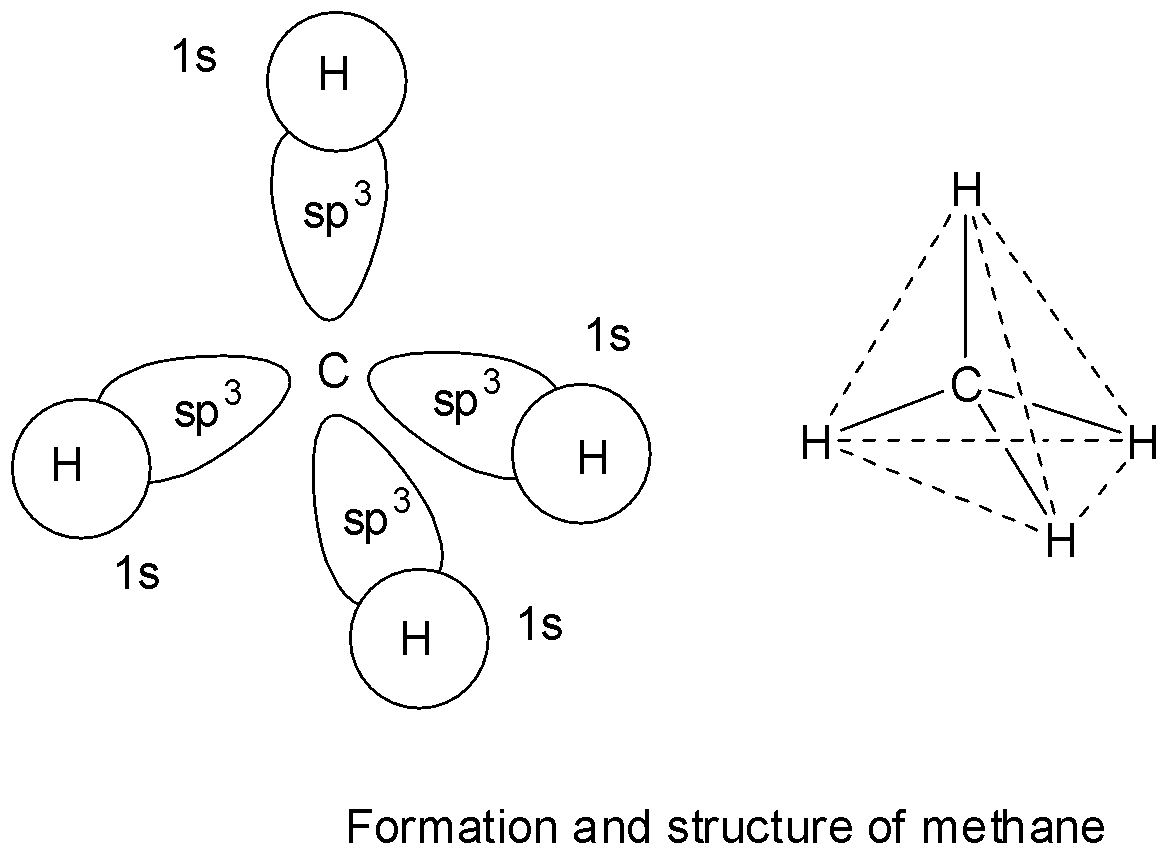
The hybridization on the central carbon in methane, ${\text{C}}{{\text{H}}_{\text{4}}}$ , is:
(A) ${\text{sp}}$
(B) ${\text{s}}{{\text{p}}^2}$
(C) ${\text{s}}{{\text{p}}^3}$
(D) ${\text{s}}{{\text{p}}^3}{\text{d}}$
Answer
124.8k+ views
Hint: The term hybridization is used to refer to the intermixing of atomic orbitals having nearly the same energies which result in their rearrangement to form completely different orbitals which are called hybrid orbitals. The hybridization and bond formation of carbon occurs in three ways: ${\text{s}}{{\text{p}}^3}$ , ${\text{s}}{{\text{p}}^2}$ and ${\text{sp}}$ hybridization.
Complete step by step answer:
In methane, carbon has 4 valence electrons and takes 4 more electrons to complete its octet. The four half filled orbitals of carbon in methane before getting involved in bond formation, mix up their energies and rearrange and redistribute equally to give four new and equivalent ${\text{s}}{{\text{p}}^3}$ hybrid orbitals which are directed at an angle of ${109^\circ }28'$ with respect to one another. These 4 ${\text{s}}{{\text{p}}^3}$ hybrid orbitals of carbon then overlap with 1s orbitals of 4 hydrogen atoms to give four ${\text{s - s}}{{\text{p}}^3}$ sigma bonds. The four bonds in methane are directed towards the 4 corners of a tetrahedron.
So, option C is correct.

* In ${\text{sp}}$ hybridization, the carbon atom in excited state is involved in the hybridization of its 2s orbital with one 2p orbital while the other two 2p orbitals are left unchanged. As a result, two new ${\text{sp}}$ hybrid orbitals form making an angle of ${180^\circ }$ with each other. The central carbon atom has linear shape. So, option A is wrong.
* In ${\text{s}}{{\text{p}}^2}$ hybridization, the carbon atom in excited state is involved in the hybridization of its 2s orbital with two 2p orbitals while the third 2p orbital is left unchanged. As a result, three new ${\text{s}}{{\text{p}}^2}$ hybrid orbitals are formed making an angle of ${120^\circ }$ with each other. So, option B is wrong.
Carbon cannot show ${\text{s}}{{\text{p}}^3}{\text{d}}$ hybridization as it is a p-block element and has no d-orbitals. So, option D is also wrong.
Note: The characteristics of hybridization are:
* The number of hybrid orbital that are formed are equal to that of the hybridizing orbitals.
* All the hybrid orbitals have equivalent energy and shape.
* Hybrid orbitals taking part in bond formation must have one electron in it.
* Electronic repulsions between the hybrid orbitals make them stay at the maximum distance apart.
Complete step by step answer:
In methane, carbon has 4 valence electrons and takes 4 more electrons to complete its octet. The four half filled orbitals of carbon in methane before getting involved in bond formation, mix up their energies and rearrange and redistribute equally to give four new and equivalent ${\text{s}}{{\text{p}}^3}$ hybrid orbitals which are directed at an angle of ${109^\circ }28'$ with respect to one another. These 4 ${\text{s}}{{\text{p}}^3}$ hybrid orbitals of carbon then overlap with 1s orbitals of 4 hydrogen atoms to give four ${\text{s - s}}{{\text{p}}^3}$ sigma bonds. The four bonds in methane are directed towards the 4 corners of a tetrahedron.
So, option C is correct.

* In ${\text{sp}}$ hybridization, the carbon atom in excited state is involved in the hybridization of its 2s orbital with one 2p orbital while the other two 2p orbitals are left unchanged. As a result, two new ${\text{sp}}$ hybrid orbitals form making an angle of ${180^\circ }$ with each other. The central carbon atom has linear shape. So, option A is wrong.
* In ${\text{s}}{{\text{p}}^2}$ hybridization, the carbon atom in excited state is involved in the hybridization of its 2s orbital with two 2p orbitals while the third 2p orbital is left unchanged. As a result, three new ${\text{s}}{{\text{p}}^2}$ hybrid orbitals are formed making an angle of ${120^\circ }$ with each other. So, option B is wrong.
Carbon cannot show ${\text{s}}{{\text{p}}^3}{\text{d}}$ hybridization as it is a p-block element and has no d-orbitals. So, option D is also wrong.
Note: The characteristics of hybridization are:
* The number of hybrid orbital that are formed are equal to that of the hybridizing orbitals.
* All the hybrid orbitals have equivalent energy and shape.
* Hybrid orbitals taking part in bond formation must have one electron in it.
* Electronic repulsions between the hybrid orbitals make them stay at the maximum distance apart.
Recently Updated Pages
The hybridization and shape of NH2 ion are a sp2 and class 11 chemistry JEE_Main

Total number of orbitals associated with the 3rd shell class 11 chemistry JEE_Main

Which of the following has the lowest boiling point class 11 chemistry JEE_Main

Which of the following compounds has zero dipole moment class 11 chemistry JEE_Main

Number of g of oxygen in 322 g Na2SO410H2O is Molwt class 11 chemistry JEE_Main

In the neutralization process of H3PO4 and NaOH the class 11 chemistry JEE_Main

Trending doubts
JEE Main 2023 January 24 Shift 2 Question Paper with Answer Keys & Solutions

Learn About Angle Of Deviation In Prism: JEE Main Physics 2025

JEE Main Login 2045: Step-by-Step Instructions and Details

Ideal and Non-Ideal Solutions Raoult's Law - JEE

Types of Solutions

Inertial and Non-Inertial Frame of Reference - JEE Important Topic

Other Pages
NCERT Solutions for Class 11 Chemistry In Hindi Chapter 8 Redox Reactions

Clemmenson and Wolff Kishner Reductions for JEE

Geostationary Satellites and Geosynchronous Satellites - JEE Important Topic

NCERT Solutions for Class 11 Chemistry In Hindi Chapter 7 Equilibrium

JEE Main 2022 June 29 Shift 2 Question Paper with Answer Keys & Solutions

Current Loop as Magnetic Dipole and Its Derivation for JEE




